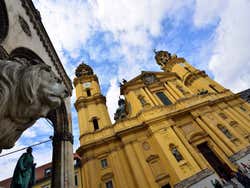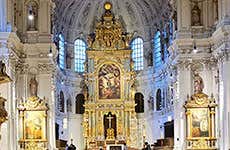
Theatinerkirche
Built in the 17th century, the Theatinerkirche boasts a striking yellow Rococo façade which has become a popular symbol of Munich.
Built between 1663 and 1690 as a symbol of gratitude for the birth of a long-awaited heir to the Bavarian crown, the Theatine Church of St. Cajetan, or Theatinerkirche as it is more simply known in German, is widely known for its impressive mustard-yellow Rococo façade, twin towers and large dome.
Visiting Theatinerkirche
Past its Rococo-style exterior, the church's interior is richly decorated in Italian Baroque style, with sweeping white stucco arches and ornate domes gleaming in the light.
One of the chapels is home to the Fürstengruft, or royal crypt, where a number of Wittelsback family members are laid to rest.
As well as being an important symbol of the city, the Theatinerkirche's elegant architecture greatly inspired the Southern German Baroque movement. The church is well worth a visit, especially if you've planned a day at the nearby Residenz and Hofgarten.


Schedule
Daily 7 am to 9 pm.
Price
Free
Transport
U-Bahn: Odeonsplatz, lines U3, U4, U5 and U6.
Bus: line 100.
Nearby places
Odeonsplatz (36 m) Munich Residenz (195 m) Hofgarten (220 m) Frauenkirche (480 m) New Town Hall (508 m)

